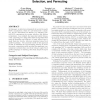Free Online Productivity Tools
i2Speak
i2Symbol
i2OCR
iTex2Img
iWeb2Print
iWeb2Shot
i2Type
iPdf2Split
iPdf2Merge
i2Bopomofo
i2Arabic
i2Style
i2Image
i2PDF
iLatex2Rtf
Sci2ools
CCS
2010
ACM
2010
ACM
Bureaucratic protocols for secure two-party sorting, selection, and permuting
In this paper, we introduce a framework for secure two-party (S2P) computations, which we call bureaucratic computing, and we demonstrate its efficiency by designing practical S2P computations for sorting, selection, and random permutation. In a nutshell, the main idea behind bureaucratic computing is to design data-oblivious algorithms that push all knowledge and influence of input values down to small black-box circuits, which are simulated using Yao’s garbled paradigm. The practical benefit of this approach is that it maintains the zero-knowledge features of secure two-party computations while avoiding the significant computational overheads that come from trying to apply Yao’s garbled paradigm to anything other than simple two-input functions. 1 Categories and Subject Descriptors K.6 [Management of Computing and Information Systems]: Miscellaneous General Terms Algorithms, Security Keywords Secure two-party computation, sorting, oblivious algorithms, bureaucratic protocols
Bureaucratic Computing | CCS 2010 | Secure Two-party Computation | Security Privacy | Yao’s Garbled Paradigm |
| Added | 18 May 2010 |
| Updated | 18 May 2010 |
| Type | Conference |
| Year | 2010 |
| Where | CCS |
| Authors | Guan Wang, Tongbo Luo, Michael T. Goodrich, Wenliang Du, Zutao Zhu |
Comments (0)

